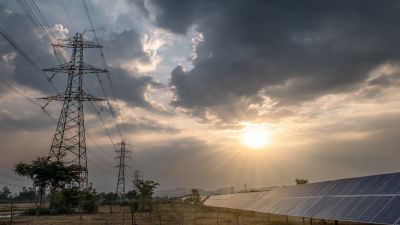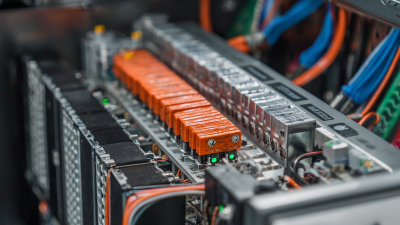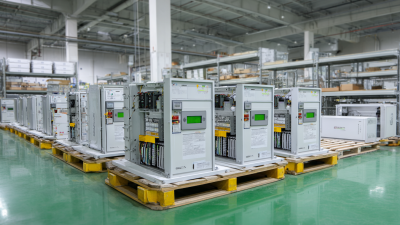SunVena Solar Blog
Residential Solar News, Insights & Resources
Mastering Your 3kw Solar Inverter Setup A Step by Step Tutorial for Beginners
In recent years, the adoption of solar energy has surged, with a remarkable 20% annual growth in the solar PV market, according to the International Energy Agency (IEA). As homeowners increasingly seek sustainable energy solutions, mastering the setup of a 3kw solar inverter has become essential. A 3kw solar inverter plays a crucial role in converting and managing solar energy, making it accessible and efficient for residential use. With a growing number of households opting for small-scale solar systems, understanding the intricacies of these inverters can significantly enhance overall energy efficiency and optimize returns on investment. By following a step-by-step approach, beginners can demystify the installation process, ensuring a smooth transition into renewable energy usage while potentially decreasing utility bills by up to 50%, as reported by the National Renewable Energy Laboratory (NREL). Embrace this opportunity to harness the power of the sun with confidence and expertise.

Understanding Solar Inverters: How 3kW Systems Operate and Their Components
Understanding solar inverters is crucial for anyone looking to harness solar energy efficiently. A 3kW solar inverter plays a key role in converting direct current (DC) generated by solar panels into alternating current (AC) suitable for household use. According to the National Renewable Energy Laboratory, properly sized inverters can increase the overall efficiency of a solar power system, with optimal inverter performance enhancing energy harvest by as much as 20%. This is particularly important for 3kW systems, which are commonly found in residential setups.
The components of a 3kW solar inverter include the inverter itself, a transformer, and monitoring equipment. These elements work together to ensure that the solar energy harnessed is usable and can be efficiently fed into the electrical grid or stored for later use. Reports from the International Energy Agency highlight that well-designed inverter systems are critical for maintaining the stability of the electrical grid as more residential solar installations come online. Therefore, understanding how these systems operate will empower beginners to make informed decisions about their solar investments.
Choosing the Right 3kW Solar Inverter: Key Specifications and Features to Consider
When choosing a 3kW solar inverter, several key specifications and features should guide your decision. First and foremost, consider efficiency ratings, as this directly influences how much solar energy is converted into usable power. Look for inverters with at least an 80-90% efficiency rating to ensure you're maximizing energy output. Additionally, check for the inverter's maximum power point tracking (MPPT) capabilities; an inverter with multiple MPPTs can optimally adapt to varying light conditions, making it ideal for installations with shade or varying orientations.
Another critical aspect is the inverter's durability and warranty. Given that solar inverters are exposed to outdoor conditions, selecting a model with a robust weather-resistance rating and a warranty of at least 5 to 10 years can save you future maintenance costs. Furthermore, features like remote monitoring capabilities allow users to track system performance in real time, showcasing how much energy is produced and identifying any issues early. These specifications will not only enhance your solar setup's longevity but also ensure you achieve optimal performance from your 3kW inverter.
3kW Solar Inverter Efficiency Comparison
Installation Essentials for Your 3kW Solar Inverter: Tools, Safety, and Best Practices
When setting up your 3kW solar inverter, understanding the installation essentials is crucial for both safety and efficiency. The first step is to gather the necessary tools, including a screwdriver, wire cutters, a multimeter, and safety gloves. These tools not only streamline the installation process but also ensure that you can handle any unforeseen challenges. Ensure you also have a sturdy ladder if your inverter is mounted higher up, and wear appropriate personal protective equipment such as goggles and gloves to protect against electrical hazards.

Safety is paramount when dealing with electrical installations. Before starting, make sure to switch off the main power supply to avoid any accidental shocks. It's advisable to familiarize yourself with local electrical codes and regulations, as these can vary significantly. Additionally, consider working with a helper to ensure that heavy equipment is handled with care and that you can quickly respond to any issues. By following best practices, such as properly grounding the inverter and using the correct gauge of wire for connections, you’re setting a solid foundation for a successful solar power system.
Optimizing Performance: Monitoring Your 3kW Solar Inverter's Efficiency and Output
When optimizing the efficiency and output of a 3kW solar inverter, it's essential to focus on monitoring tools and strategies that allow for real-time assessment of performance. Understanding key metrics such as energy conversion efficiency, output voltage, and current can help users identify any potential issues early on. Effective monitoring systems can provide insights into the inverter's operational efficiency, contributing to predictive maintenance and lifecycle modeling. Integrating advanced telemetry data reporting capabilities significantly enhances the ability to maintain optimal performance, as users can anticipate maintenance needs before problems escalate.
As the global inverter market is projected to grow significantly, particularly within the renewable energy sector, investing time in understanding how to monitor and optimize inverter performance is crucial. Techniques like maximum power point tracking (MPPT) testing ensure that solar systems operate at peak efficiency, aligning with global sustainability goals. With innovations in inverter technology, users have more tools than ever to not only monitor but also adjust their systems for better energy yield, ultimately contributing to a greener future.

Troubleshooting Common Issues with 3kW Solar Inverter Setups: Tips for Quick Resolutions
When setting up a 3kW solar inverter, beginners may encounter common issues that can disrupt their experience. One frequent problem is insufficient power generation, often caused by shading on the solar panels or improper alignment. It's crucial to ensure that your panels are free from obstructions and facing the optimal direction for maximum sunlight exposure. Regular inspections and cleaning can mitigate these issues, helping to maintain the efficiency of your solar power system.
Another issue to be aware of is inverter error codes, which can signal various problems from overheating to grid connection issues. Familiarize yourself with the user manual of your specific inverter model, as it usually provides detailed information on what each error code means and how to address it. Often, a simple reset or checking the wiring connections can resolve these errors. Additionally, monitoring your inverter's performance through online platforms or apps can help you catch potential problems early, allowing for timely interventions and ensuring a seamless solar energy experience.
Mastering Your 3kW Solar Inverter Setup
| Issue | Possible Causes | Quick Resolutions |
|---|---|---|
| Inverter Not Turning On | Power supply issues, Faulty circuits, Switches turned off | Check power source, Restart the inverter, Inspect fuses and circuits |
| Low Output Voltage | Weak sunlight, Dirty panels, Wiring issues | Clean solar panels, Check wiring connections, Optimize panel angle |
| Overheating | Poor ventilation, High ambient temperatures | Ensure adequate airflow, Install a cooling fan, Relocate inverter |
| Frequent Tripping | Overload, Faulty components | Reduce load, Check for component failures |
| Error Codes Displayed | System malfunctions, Firmware issues | Refer to manual for codes, Update firmware |
Related Posts
-

Mastering Your Solar System with the Best Must Solar Inverter Selection Guide
-

Mastering Hybrid Solar Inverters: A Comprehensive Guide to Boosting Energy Efficiency by 30%
-

Navigating Import and Export Certifications for Best on Grid Solar Inverters in the Global Market
-

How to Choose the Right Solar River Inverter for Your Energy Needs
-

Innovative Examples of RV Solar Inverter Technologies Shaping Sustainable Travel
-

Unlocking Energy Independence with Solar Power Inverter for Home Benefits